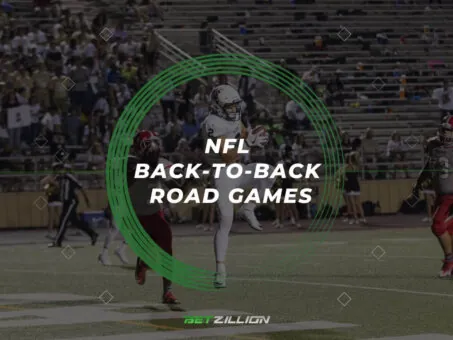This website uses cookies so that we can provide you with the best user experience possible. Cookie information is stored in your browser and performs functions such as recognising you when you return to our website and helping our team to understand which sections of the website you find most interesting and useful.
The Zig-Zag Theory Explained

The zig-zag theory is credited to professional bettor and handicapper Tony Salinas. According to the theory, you should stake on the team that lost its previous game in a playoff series. Salinas successfully applied it to the NBA playoffs in the 1990s. He specifically thought that almost all bookies rarely account for the motivation and tactical adjustments of the losing team and instead focus on other factors such as home advantage.
The zig-zag theory definition claims that teams have a higher chance of winning or covering the spread in a playoff game after a loss. In the NBA, teams that are 0-2 in the postseason series have won Game 3 in 56% of the cases.
The idea behind the theory is that bookies usually underestimate teams in that position. They’ve already lost 2 matches in a row, so they are given fewer chances to win the next one due to perceived poor form or lack of strength. Zig-zag is best suited for the NBA and NHL thanks to their best-of-seven playoff format. Of course, it’s not a proven theory, but the prevalence of teams that win their games after going 2-0 down holds significant value in sports betting.
How Does Zig-Zag Theory Work?
In the simplest terms, it suggests that when a team loses one match, it should cover the spread in the next. Bouncing back from losses is a key element of the zig-zag theory. It takes into account that the winning team might be overconfident or less motivated. The home advantage and the recent form of teams are also considered.
It mainly applies to the NBA and the NHL, where spread bets work best. The theory can also be used for MLB to some degree. It isn’t fit for the NFL because of the league’s single-game elimination format in the playoffs.
NBA Zig-Zag Theory
The zig-zag originated as a strategy for betting on NBA playoffs. This is where it’s most efficient because teams repeatedly face each other in the series, alternate home advantage, and momentum swings are high. Punters can apply it in a few different ways, including:
- In Game 1 of a playoff series, the home team is favored to win due to playing in their home arena and being the higher seed. But if the home team loses the game, they are likely to win Game 2. The theory expects them to be motivated to bounce back in front of their own fans and avoid being 0-2 ahead of the road game.
- According to the zig-zag theory, a team that has experienced two losses in a row since the beginning of the playoff series is likely to win Game 3. The chances of them doing so are especially high if the game is played at their home court.
- Teams that are 0-3 in the series are also more likely to bounce back and win Game 4 in order to avoid being swept.
A typical example of the zig-zag theory was the 2022 NBA Finals between the Golden State Warriors and Boston Celtics. The Celtics, playing on the road, won Game 1. The Warriors bounced back in Game 2 to get an 88–107 win. Game 3 saw the Celtics recovering from their first loss and achieving another victory, resulting in a 2-1 lead. The Warriors came back in Game 4 to tie the series again and then went on to win the next two games, claiming the NBA title. In this particular case, punters who followed the zig-zag approach would have made three straight winning bets.
The 2021 NBA finals, where the Phoenix Suns played against the Milwaukee Bucks, are another example. The Suns clinched the first victory in Game 1 of the series and then went on to win Game 2. According to the zig-zag theory, the Bucks had higher chances of winning Game 3 because they were coming off two straight losses and were about to play at home. Betting on them paid off because Milwaukee won 110-120. The Bucks won the remaining games in the series and were crowned NBA champions.
Some Things to Consider for the NBA and Zig-Zag Theory
The zig-zag theory for the NBA isn’t foolproof. Punters looking to use it need to consider other factors that can affect the eventual outcome of a game. Those include the home court advantage, opposing teams’ dynamic, recent performances, head-to-head record, injuries and suspensions, and others.
Brief History of Zig-Zag Theory in the NBA
The concept has been around for decades, but became popular in the NBA in the 1990s. During that era, bettors noticed that losing teams would frequently win the next match, especially if they suffered two defeats in a row. It was a simple but efficient strategy, especially in the absence of advanced tools used for outcome predictions. It allowed punters to enjoy incredible payouts with their zig-zag bets from 1990 to 2000.
Marc Lawrence, a professional bettor, analyzed the use of zig-zag in the NBA to see how it has evolved. He discovered that the theory had changed drastically and had become less effective. Lawrence found that from 1991 to 2000, utilizing the theory yielded a 55.5% success rate.
From 2001 to 2013, the success rate for zig-zag betting in the NBA playoffs dipped to 51.6%. It is significantly lower compared to the Golden 90s, but it remains a decent win rate that sharp punters can exploit to their advantage.
Why the NBA Zig-Zag Theory has Changed
The zig-zag strategy has become less effective in the NBA since the 1990s. There are a few reasons why this is the case. One of the most significant factors that has changed the NBA landscape is the emergence of super teams in later eras. Dominant teams are more likely to keep the winning momentum. Also, the NBA head coaches have become more focused on adjusting their strategies for each matchup. The increased reliance on three-point shooting has played a role as well. The teams can unexpectedly get “hot” or “cold” from behind the arc and change the course of the entire game.
Some of the other contributing factors to the change include:
- Evolution in team strategies
- Availability of analytics and advanced metrics
- Changes in playoff formats
- Variability in home court advantage
NHL Zig-Zag Theory
The NHL is the other major sports league where the zig-zag theory applies effectively. During the playoff series, losing teams can make a comeback to avoid being in a significant deficit or getting swept away by their opponent. Like in the NBA, you can apply the theory here to back a losing team to win Game 2. You can also back such a team to win Game 3 after two consecutive losses.
We’ll use the 2020 Stanley Cup Finals, which pitted the Tampa Bay Lightning against the Dallas Stars, as an example. The Stars opened the series to win Game 1. The Lighting came back in a close match in Game 2, creating an ideal outcome for zig-zag punters. Tampa Bay subsequently won the following two games to take a 3-1 lead in the series. Dallas, facing elimination, responded with a win in Game 5 to reward bettors who used a zig-zag approach. The Lightning would go on to take Game 6 and win the series 4-2.
The 2022 Stanley Cup Finals, between the Tampa Bay Lightning and Colorado Avalanche, offer another example. The series started with the Avalanche leading during the first two games. A zig-zag opportunity opened up in Game 3 as the Lightning were motivated to make a comeback, which they ended up doing. The next opportunity came up in Game 5, with Colorado leading 3-1. Based on the zig-zag theory, the Lightning were highly motivated to win Game 5 and stay alive in the series. This proved right, as Tampa Bay won the game. The Avalanche went on to win Game 6 and lift the Stanley Cup.
Some Things to Consider for the NHL and Zig-Zag Theory
Like the NBA, you should always watch for other elements influencing a matchup between two opposing teams. Don’t rely on the zig-zag theory alone. Also consider player injuries or suspensions, coaching strategy, goalie performance, home ice advantage, and recent form.
Scenarios to Look for When Betting Zig-Zag Theory
When using this theory in practice, there are several scenarios you should look for.
Home Team Loses the First Game
If the home team loses the first game, you should back it to win the next one. These teams are more motivated to win the second game if they surprisingly lose the first one. They want to avoid falling to a 0-2 deficit and have a tougher time equalizing the series. Their opponents might also be content to “steal” one game on the road.
Home Team Is Down 2-0
In cases where the home team is down 2-0, there is a high chance they will look to bounce back and win Game 3. Besides having home advantage, they will be highly motivated to get back in the series. No team in NBA history came back from a 0-3 deficit to win the series. It also only happened 4 times in the NHL and once in MLB.
Home Team Facing a Sweep
Home teams that are facing a sweep are also strong contenders for the zig-zag theory. No team wants to lose four games in a row and be eliminated from the playoffs without a win, especially in front of their own fans.
Reasons to Use Zig-Zag Theory Cautiously
There is no denying that the zig-zag theory can be an effective strategy to win some payday in online betting. But it doesn’t offer any guarantees. It is a guideline and a resource based on historical statistics and probabilities that can aid punters in making good decisions.
It is crucial to be cautious when implementing the zig-zag theory in your betting strategy. Here are some key factors you should consider to increase your winning chances.
The Matchup
The most significant factor to consider is the matchup between the two teams involved in the game you are interested in. You should check out the records of both contenders and see how they have been performing in recent games.
The history between the two teams and how they have fared against each other is also important. Doing this will let you know if the outcome of the matchup is leaning heavily towards one side.
Split Stats
The split stats are another essential consideration that punters must note before using the zig-zag theory. Split stats show how a team or player performed historically in certain situations. For example, they can tell you how Lebron James performed in Game 1 of the NBA Finals throughout his career. You can also see his success against a specific team or division.
Sports database websites like Basketball Reference and Hockey Reference are a great source of split stats for the NBA or NHL games you want to apply zig-zag to. Checking them out before placing playoff bets will increase your chances of winning.
Injuries
Injuries are a frequent occurrence in sports, especially in more physical leagues like the NHL. Having an injured key player during a matchup can affect a team’s performance. The team often isn’t able to replace his production while also having to make tactical adjustments. That’s why it’s crucial to stay up-to-date on the latest injury reports.
Check the injury reports for both teams involved in a game, and see if it can influence your bet. It could save you from putting action on a losing game.
Suspensions
Like the injury factor, an important player’s suspension can disrupt a team’s performance during a matchup. This is another crucial factor you should consider before placing a bet using the zig-zag approach. It is especially the case when wagering on the NHL playoffs, as suspension happens more frequently.
You should check out the suspension list ahead of each game by doing a quick online search. This way, you can determine if the team you want to back has a suspended player and whether their absence can have a significant influence on the performance.
Other Things to Consider Before Applying Zig-Zag Theory
Besides the teams in a matchup, split stats, injuries, and suspensions, you could consider many other things before implementing the zig-zag theory for your bet. Some of these are quantitative factors that you may be able to browse and find online easily. Others are qualitative, which require reflection, critical thinking, and sometimes gut decisions.
A few examples of qualitative factors include team motivation and series momentum.
Team Motivation
Checking out the statistics and numbers regarding the teams involved in a matchup is essential. But it is also vital to pay attention to their motivation. One team might be more motivated to win compared to their opponents. They might get a boost from playing at home, facing elimination, or playing a team that beat them in the previous postseason.
Before you place your bet based on the zig-zag theory, carefully consider the contenders’ motivation in the matchup.
Series Momentum
The series momentum is also a key factor for the zig-zag theory. Although it asks you to always back the losing team in the next game, this is not always the best action. You should consider the manner in which the team lost the game and how that might influence their momentum. The loss they experienced might be so bad that you can’t imagine them bouncing back. Their performance in the series could also be so terrible that betting on them seems like a poor decision.
The figures and stats in a series are essential to making your zig-zag betting decisions, but you should also consider qualitative factors that can come into play.
Taking Advantage of the Zig-Zag Theory
Now that you know how it works in the NBA and NHL, let’s discuss taking advantage of the zig-zag theory. Here are some tips that can help you improve your chances of succeeding with this approach:
| Tips | Explanation |
|---|---|
| Use together with other betting strategies | Zig-zag theory is not 100% guaranteed. It is essential to use it with other betting strategies to improve its chances of being effective. |
| Only consider teams motivated to win | The zig-zag theory is based on the idea that a motivated team is more likely to win after suffering a loss in its previous game during the playoffs, especially if it is a 2-0 loss. As a result, betting on a team that seems unmotivated would not be the best decision. |
| Target teams with an excellent home-court advantage | The home-court advantage is a real concept in sports, especially in the NBA and NHL. Teams that play at home are more likely to win their matchup. |
| Bet on the teams performing well | A team’s recent form is generally a good indicator of future performance. Always target teams on a strong run for your zig-zag bet, as they are likely to bounce back more easily. |
| Bet on teams with an excellent head-to-head | If the two teams facing off have played each other recently, you should find out which has the better head-to-head record. They are more likely to win the game. |
| Be patient | Like most betting strategies, the zig-zag theory is not a get-rich-quick scheme. It will take time and patience to be profitable in the long run. |
The zig-zag theory is a tool to help you improve your winning chances and not a strategy you should use all the time.
Profitability of the Zig-Zag Theory
The zig-zag theory can be profitable, but it is not a guaranteed way to win money. It was a successful way of making money in the 1990s, but its efficiency has dropped since then. The profitability depends on a few factors, including the specific teams involved in the matchup, injuries, suspensions, and other vital factors. Make sure you research to find the most profitable wagers when you want to make a betting decision based on this theory.
Zig-Zag Theory Statistics
The most important statistic that supports the zig-zag theory is the previously mentioned research from Marc Lawrence. His data shows that the approach had a 55.5% success rate between 1991 and 2000 NBA playoffs when betting on losing teams to cover the spread in their following game. Between 2001 and 2013, the rate was 51.6% percent. However, the theory still works for Game 2, where the loser of the previous game covers the spread 56.2% of the time.
We can also look at the statistics provided by Champs or Chumps. According to their database, which goes all the way back to the 1949 Finals, teams down 0-2 in the series have won Game 3 in 54.6% of the cases.
You will find various other statistics attached to zig-zag theory online, but they usually lack sources or explanations to support the numbers.
Is It Worth Using a Zig-Zag Theory?
Yes, it is, but you should always do it cautiously. Read tips and strategies by experts before you try it out. Use the information contained in this guide to identify the best scenarios for the theory. Make sure you use it at VIP bookmakers, as they offer better value on the odds to make the theory relevant and profitable.
Frequently Asked Questions
-
Is the zig-zag theory profitable?It can be profitable when used in certain situations. It works best with Game 3 when the lower-seeded team trails 2-0 and plays at home. In that case, you can expect to win your bets in most cases, but still, there’s no guarantee.
-
How to use zig-zag theory in NBA playoffs betting?Using the zig-zag theory works best in the NBA playoffs. It’s especially efficient when the stronger team loses Game 1 at home or the underdog plays its first home game after losing the previous two.
-
How to start using the zig-zag betting theory?You’ll need to do your research before using the zig-zag theory. Our guide is a good start, but also check out tips, strategies, and expert predictions. This will help you put your money on playoff games that make the most sense.
-
Still have questions?
Ask our experts
Related articles
Flat Betting
NFL Back-to-Back Road Games Betting





